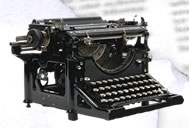A short paragraph about the M-Dogs of the American Army during the Second World War and how they were trained to locate both plastic and metallic mines during the course of the war.
An additional paragraph can be read about the Hollywood starlet who volunteered her dog for military service, only to be informed that the pooch had given the last full measure on behalf of democracy and a grateful nation.
Click here to read an article about re-educating the captured German boys of the war.
The use of animals in war is as old as war itself; but the concept of kicking dogs out of perfectly good aircraft so they might be able to parachute onto snowy hilltops and deliver aid to wounded combatants dates to World War II. This printable "Collier's Magazine" article tells the story of the "Parapups":
"Completely G.I., the dogs have service records, serial numbers, enlistment papers and shots against disease. Sentimentalists along the Alaska Division even proposed that they be authorized to wear Parawings after five jumps."
Although historians may like to refer to World War II as "the first hi-tech war", some of the ancient tools were still put to use with great effect. The attached article gives a very brief outline concerning the W.W. II use of carrier pigeons and the goings on at Camp Crowder, Missouri, where these birds were trained.
"Since 1400 B.C. these birds have acted as couriers; they are the oldest instruments of war still in use. Although they form only a small part of our tremendous Signal Corps resources, the Army maintains a corps of expert pigeoneers who have rendered their birds, by scientific training and breeding, ten percent stronger than those used in World War One."
During the course of World War II the U.S. Army signal Corps deployed more than 50,000 carrier pigeons.
You might also enjoy reading this article about the carrier pigeons of W.W. I.
This is a highly amusing collection of photos depicting the seldom remembered "Para-Sheep" of the Italian Army during their adventures in Ethiopia. It would seem that Italian grunts simply would not stomach canned food the way other infantrymen were able to do and so it was decided that sheep would be individually rigged with parachutes and tossed out of planes, where they would be butchered and cooked by the Mussolini's men below. The accompanying paragraph explains that even a bull had been air-dropped from the same purpose.
Take a look.
Dogs for Defense was a World War II organization founded by three patriotic dog enthusiasts who established the group in order to procure patriotic
canines (meeting certain height and weight standards) for the U.S. Army Quartermaster Corps, that branch of the services charged with the task of training the animals. Dogs for Defense was able to provide as many as four hundred dogs a week for the U.S. Army throughout both W.W. II as well as the Korean War.
The attached article can be printed.
This is the story of "Tich" - the little black dog was the well-loved pet of the British Eighth Army. An admired veteran of three bitter World War II campaigns, she saw battle from North Africa to Sicily and on to Paris - thousands of Allied troops came to know her and like her. Due to her ability to predict in-coming artillery shells, many men owed their lives to her.
On July 1, 1949 Tich was awarded the Dickin Medal at Wembley Stadium, cheered by 10,000 onlookers. Ironically, having survived combat for nearly five straight years, Tich allowed malaria to get the better of her; she was buried at Ilford Animal Cemetery in her adopted home country.
